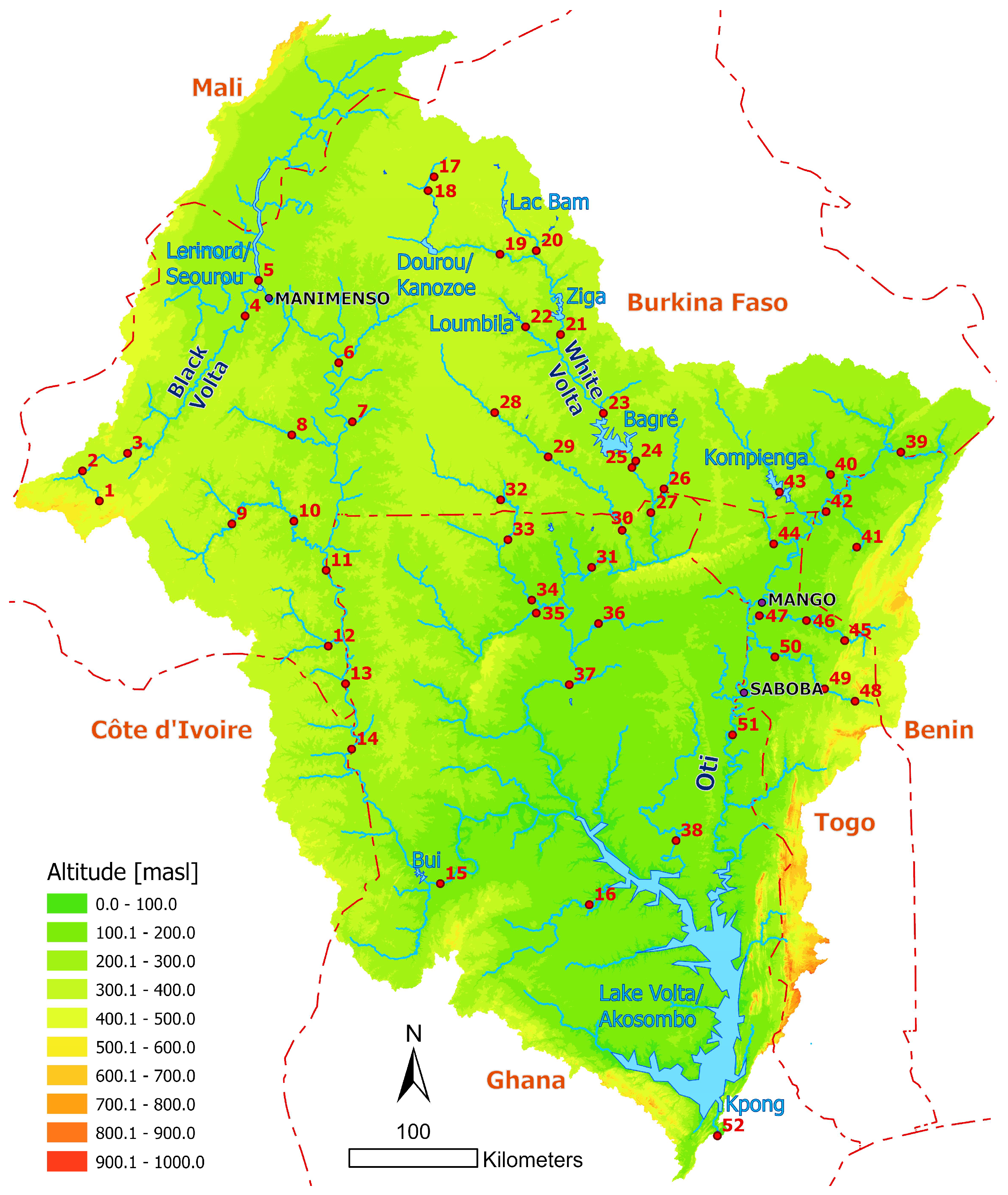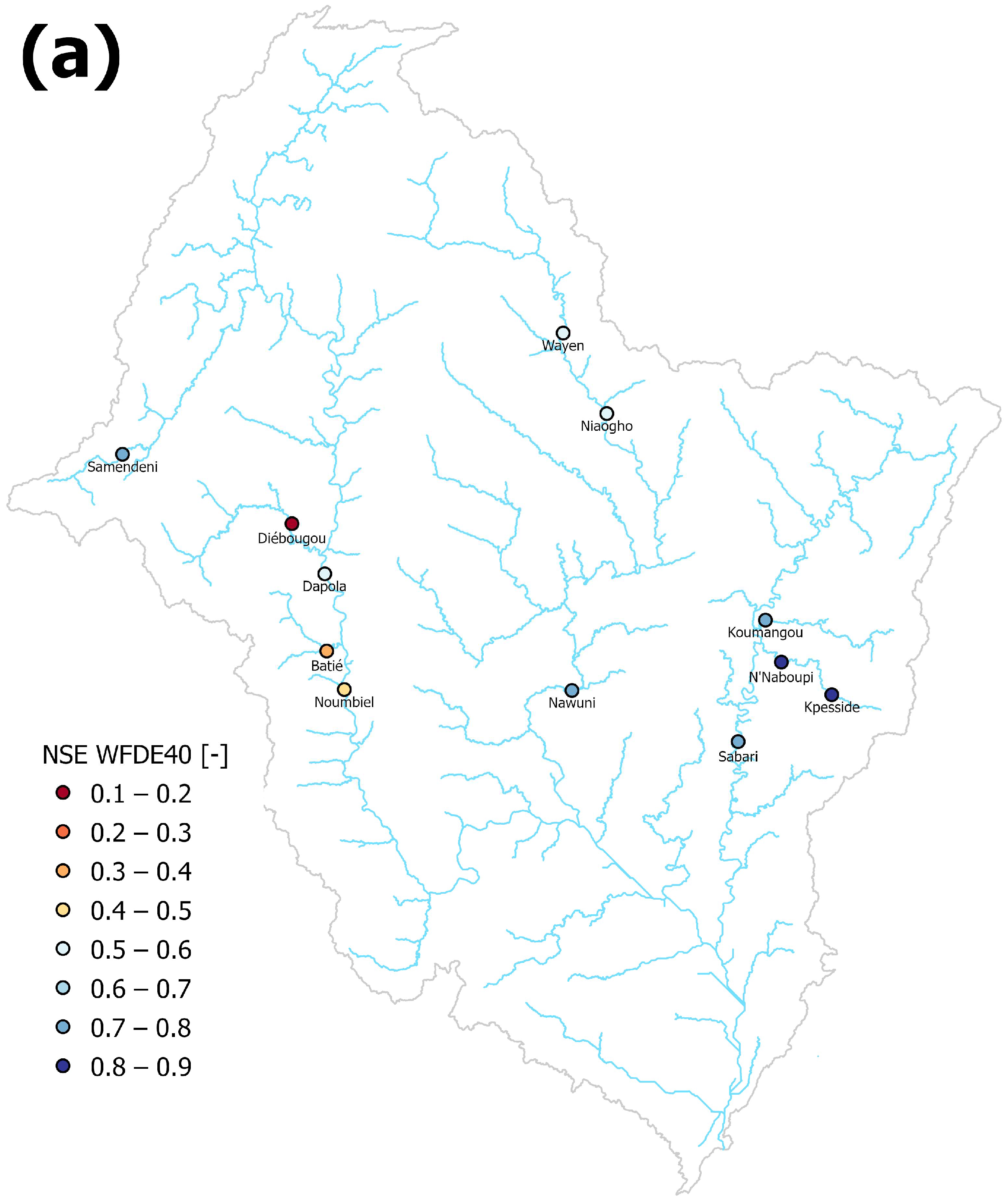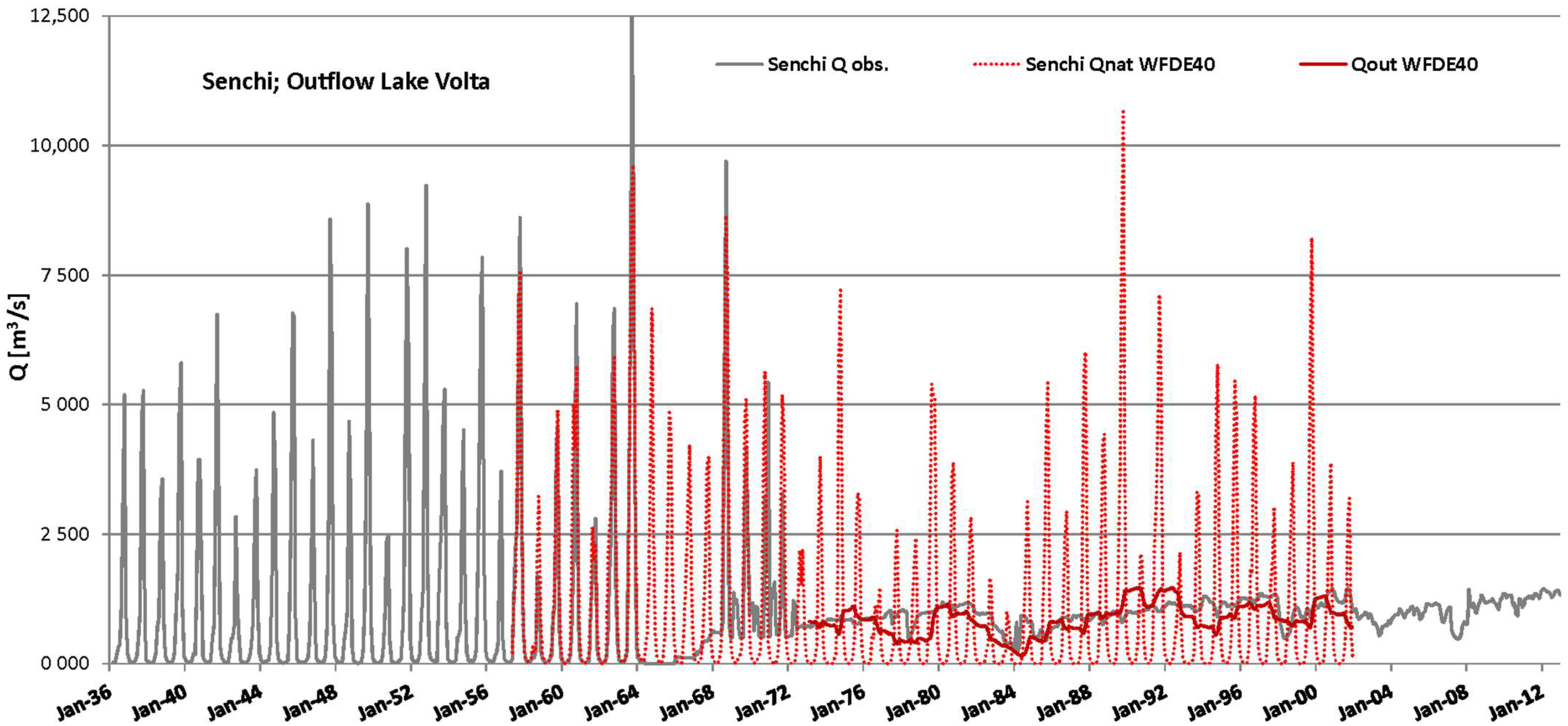From Data Scarcity to Solutions: Hydrological and Water Management Modeling in a Highly Managed River Basin
Abstract
:1. Introduction
2. Data and Methods
2.1. The Volta River Basin
2.2. The Eco-Hydrological Model SWIM
2.3. Meteorological Data
2.4. Hydrological Data
- In intermittent, highly dynamic rivers, as found in large parts of the VRB, the monthly time step masks the very dynamic runoff behavior;
- There may be flaws in monthly time series. For instance, in September 1999 a monthly mean flow of 2830 m3/s is given for gauge Bamboi (GRDC No. 1531100, No. 15 in Figure 1), where the daily time series shows that data are only available for the first seven days of this month (giving exactly the same mean flow of 2830 m3/s for these seven days).
2.5. Reservoir Data
2.6. Land Use/Cover
2.7. Parameter Optimization
2.8. Data Manipulation/Gap Filling
3. Results
3.1. Evaluation of Meteorological Data Sets
3.2. River Discharge
3.3. Reservoirs
4. Discussion
5. Conclusions
Supplementary Materials
Author Contributions
Funding
Data Availability Statement
Acknowledgments
Conflicts of Interest
References
- Hattermann, F.F.; Huang, S.; Koch, H. Climate change impacts on hydrology and water resources. Met. Z. 2015, 24, 201–211. [Google Scholar] [CrossRef]
- Lobanova, A.; Liersch, S.; Nunes, J.P.; Didovets, I.; Stagl, J.; Huang, S.; Koch, H.; López, M.R.R.; Maule, C.F.; Hattermann, F.F.; et al. Hydrological impacts of moderate and high-end climate change scenarios across European River basins. J. Hydrol. Reg. Stud. 2018, 18, 15–30. [Google Scholar] [CrossRef]
- Qin, W.; Xu, H.; Liu, M.; Liu, L.; Xiao, C.; Mallakpour, I.; Rahnamay Naeini, M.; Hsu, K.; Sorooshian, S. Projected impacts of climate change on major dams in the Upper Yangtze River Basin. Clim. Change 2022, 170, 8. [Google Scholar] [CrossRef]
- Nijssen, B.; Lettenmaier, D.P. Effect of precipitation sampling error on simulated hydrological fluxes and states: Anticipating the Global Precipitation Measurement satellites. J. Geophys. Res. 2004, 109, 1–15. [Google Scholar] [CrossRef]
- Blöschl, G.; Zehe, E. On hydrological predictability. Hydrol. Process. 2005, 19, 3923–3929. [Google Scholar] [CrossRef]
- Strauch, M.; Bernhofer, C.; Koide, S.; Volk, M.; Lorz, C.; Makeschin, F. Using Precipitation Data Ensemble for Uncertainty Analysis in SWAT Streamflow Simulation. J. Hydrol. 2012, 414–415, 413–424. [Google Scholar] [CrossRef]
- Thoms, M.C.; Sheldon, F. Water resource development and hydrological change in a large dryland river: The Barwon-Darling River, Australia. J. Hydrol. 2000, 228, 10–21. [Google Scholar] [CrossRef]
- De Wit, M.J.M.; van den Hurk, B.; Warmerdam, P.M.M.; Torfs, P.J.J.F.; Roulin, E.; van Deursen, W.P.A. Impact of climate change on low-flows in the river Meuse. Clim. Change 2007, 82, 351–372. [Google Scholar] [CrossRef]
- Lopez-Moreno, J.I.; Vicente-Serrano, S.M.; Begueria, S.; Garcia-Ruiz, J.M.; Portela, M.M.; Almeida, A.B. Dam effects on droughts magnitude and duration in a transboundary basin: The Lower River Tagus, Spain and Portugal. Water Resour. Res. 2009, 45, W02405. [Google Scholar] [CrossRef]
- Omer, A.; Wang, W.; Basheer, A.K.; Yong, B. Integrated assessment of the impacts of climate variability and anthropogenic activities on river runoff: A case study in the Hutuo River Basin, China. Hydrol. Res. 2017, 48, 416–430. [Google Scholar] [CrossRef]
- Xu, X.; Yang, H.; Yang, D.; Ma, H. Assessing the impacts of climate variability and human activities on annual runoff in the Luan River basin, China. Hydrol. Res. 2013, 44, 940–952. [Google Scholar] [CrossRef]
- Liersch, S.; Koch, H.; Abungba, J.A.; Salack, S.; Hattermann, F.F. Attributing synergies and trade-offs in water resources planning and management in the Volta River basin under climate change. Environ. Res. Lett. 2023, 18, 014032. [Google Scholar] [CrossRef]
- Koch, H.; Liersch, S.; de Azevedo, J.R.G.; Silva, A.L.C.; Hattermann, F.F. Assessment of observed and simulated low flow indices for a highly managed River basin. Hydrol. Res. 2018, 49, 1831–1846. [Google Scholar] [CrossRef]
- Oguntunde, P.G.; Friesen, J.; van de Giesen, N.; Savenije, H.H. Hydroclimatology of the Volta River Basin in West Africa: Trends and variability from 1901 to 2002. Phys. Chem. Earth Parts A/B/C 2006, 31, 1180–1188. [Google Scholar] [CrossRef]
- Neumann, R.; Jung, G.; Laux, P.; Kunstmann, H. Climate trends of temperature, precipitation and river discharge in the Volta Basin of West Africa. Int. J. River Basin Manag. 2007, 5, 17–30. [Google Scholar] [CrossRef]
- Conway, D.; Persechino, A.; Ardoin-Bardin, S.; Hamandawana, H.; Dieulin, C.; Mahe, G. Rainfall and Water Resources Variability in Sub-Saharan Africa during the Twentieth Century. J. Hydrometeorol. 2009, 10, 41–59. [Google Scholar] [CrossRef]
- Liersch, S.; Fournet, S.; Koch, H.; Djibo, A.G.; Reinhardt, J.; Kortlandt, J.; Weert, F.V.; Seidou, O.; Klop, E.; Baker, C.; et al. Water resources planning in the Upper Niger River basin: Are there gaps between water demand and supply? J. Hydrol. Reg. Stud. 2019, 21, 176–194. [Google Scholar] [CrossRef]
- Hulme, M. Climatic perspectives on Sahelian desiccation: 1973–1998. Glob. Environ. Change 2001, 11, 19–29. [Google Scholar] [CrossRef]
- Mahé, G.; Paturel, J.E. 1896–2006 Sahelian annual rainfall variability and runoff increase of Sahelian Rivers. Comptes Rendus Geosci. 2009, 341, 538–546. [Google Scholar] [CrossRef]
- Mahé, G.; Lienou, G.; Descroix, L.; Bamba, F.; Paturel, J.E.; Laraque, A.; Meddi, M.; Habaieb, H.; Adeaga, O.; Dieulin, C.; et al. The rivers of Africa: Witness of climate change and human impact on the environment. Hydrol. Process. 2013, 27, 2105–2114. [Google Scholar] [CrossRef]
- Nka, B.N.; Oudin, L.; Karambiri, H.; Paturel, J.E.; Ribstein, P. Trends in floods in West Africa: Analysis based on 11 catchments in the region. Hydrol. Earth Syst. Sci. 2015, 19, 4707–4719. [Google Scholar] [CrossRef]
- Descroix, L.; Guichard, F.; Grippa, M.; Lambert, L.A.; Panthou, G.; Mahé, G.; Gal, L.; Dardel, C.; Quantin, G.; Kergoat, L.; et al. Evolution of Surface Hydrology in the Sahelo-Sudanian Strip: An Updated Review. Water 2018, 10, 748. [Google Scholar] [CrossRef]
- Panthou, G.; Vischel, T.; Lebel, T. Recent trends in the regime of extreme rainfall in the Central Sahel. Int. J. Climatol. 2014, 34, 3998–4006. [Google Scholar] [CrossRef]
- Salack, S.; Saley, I.A.; Lawson, N.Z.; Zabré, I.; Daku, E.K. Scales for rating heavy rainfall events in the West African Sahel. Weather Clim. Extrem. 2018, 21, 36–42. [Google Scholar] [CrossRef]
- Schuol, J.; Abbaspour, K. Calibration and uncertainty issues of a hydrological model swat, applied to west africa. Adv. Geosci. 2006, 9, 137–143. [Google Scholar] [CrossRef]
- Obuobie, E. Estimation of Groundwater Recharge in the Context of Future Climate Change in the White Volta River Basin, West Africa. Ph.D. Thesis, Rheinische Friedrich-Wilhelms-Universität Bonn. Ecology and Development Series, Bonn, Germany, 2008. [Google Scholar]
- Awotwi, A.; Kumi, M.; Jansson, P.; Yeboah, F.; Nti, I. Predicting hydrological response to climate change in the white volta catchment, west Africa. J. Earth Sci. Clim. Change 2015, 6, 1–7. [Google Scholar] [CrossRef]
- Awotwi, A.; Yeboah, F.; Kumi, M. Assessing the impact of land cover changes on water balance components of white volta basin in west Africa. Water Environ. J. 2015, 29, 259–267. [Google Scholar] [CrossRef]
- Abubakari, S.; Dong, X.; Su, B.; Liu, J.; Li, Y.; Peng, T.; Ma, H.; Wang, K.; Xu, S. Modelling the spatial variation of hydrology in volta river basin of west Africa under climate change. Nat. Environ. Pollut. Technol. 2017, 16, 1095–1105. [Google Scholar]
- Sawai, N.; Kobayashi, K.; Takara, K.; Ishikawa, H.; Yokomatsu, M.; Samaddar, S.; Kranjac-Berisavljevic, G. Impact of Climate Change on River Flows in the Black Volta River. J. Disaster Res. 2014, 9, 432–442. [Google Scholar] [CrossRef]
- Mutsindikwa, T.C.; Yira, Y.; Bossa, A.Y.; Hounkpè, J.; Salack, S.; Saley, I.A.; Rabani, A. Modeling climate change impact on!the!hydropower potential of the Bamboi catchment. Model. Earth Syst. Environ. 2021, 7, 2709–2717. [Google Scholar] [CrossRef]
- Ouedraogo, Y.; Yamegueu, D.; Tazen, F.; Leye, B.; Bologo-Traore, M.; Konda, M. Addressing the Water-Energy-Food Nexus in the context of climate change: The case of Bagré dam in Burkina Faso. Sci. Afr. 2024, 24, e02251. [Google Scholar] [CrossRef]
- Kwawuvi, D.; Mama, D.; Agodzo, S.K.; Hartmann, A.; Larbi, I.; Bessah, E.; Limantol, A.M.; Dotse, S.Q.; Yangouliba, G.I. Spatiotemporal variability and change in rainfall in the Oti River Basin, West Africa. J. Water Clim. Change 2022, 13, 1151–1169. [Google Scholar] [CrossRef]
- Karambiri, H.; García Galiano, S.G.; Giraldo, J.D.; Yacouba, H.; Ibrahim, B.; Barbier, B.; Polcher, J. Assessing the impact of climate variability and climate change on runoff in West Africa: The case of Senegal and Nakambe River basins. Atmos. Sci. Lett. 2011, 12, 109–115. [Google Scholar] [CrossRef]
- Bracken, L.J.; Cox, N.J.; Shannon, J. The relationship between rainfall inputs and flood generation in south-east Spain. Hydrol. Process. 2008, 22, 683–696. [Google Scholar] [CrossRef]
- Camarasa, A.M.; Tilford, K.A. Rainfall-runoff modelling of ephemeral streams in the Valencia region eastern Spain. Hydrol. Process 2002, 16, 3329–3344. [Google Scholar] [CrossRef]
- Arnold, J.G.; Allen, P.M.; Bernhardt, G. A comprehensive surface groundwater flow model. J. Hydrol. 1993, 142, 47–69. [Google Scholar] [CrossRef]
- Krysanova, V.; Meiner, A.; Roosaare, J.; Vasilyev, A. Simulation modelling of the coastal waters pollution from agricultural watershed. Ecol. Model. 1989, 49, 7–29. [Google Scholar] [CrossRef]
- NASA. SRTM 90m Digital Elevation Data. National Aeronautics and Space Administration 2011. Available online: https://srtm.csi.cgiar.org/ (accessed on 11 December 2018).
- FAO. Digital Soil Map of the World 2011. Available online: https://www.fao.org/soils-portal/data-hub/soil-maps-and-databases/faounesco-soil-map-of-the-world/en/ (accessed on 11 December 2018).
- Koch, H.; Liersch, S.; Hattermann, F.F. Integrating water resources management in eco-hydrological modelling. Water Sci. Technol. 2013, 67, 1525–1533. [Google Scholar] [CrossRef]
- Weedon, P.G.; Gomes, S.; Viterbo, P.; Shuttleworth, J.W.; Blyth, E.; Österle, H.; Adam, C.J.; Bellouin, N.; Boucher, O.; Best, M. Creation of the WATCH Forcing Data and its use to assess global and regional reference crop evaporation over land during the twentieth century. J. Hydrometeorol. 2011, 12, 823–848. [Google Scholar] [CrossRef]
- Cucchi, M.; Weedon, G.P.; Amici, A.; Bellouin, N.; Lange, S.; Schmied, H.M.; Hersbach, H.; Buontempo, C. WFDE5: Bias adjusted ERA5 reanalysis data for impact studies. Earth Syst. Sci. Data. 2020, 12, 2097–2120. [Google Scholar] [CrossRef]
- Moniod, F.; Pouyaud, B.; Sechet, P. Le Bassin du Fleuve Volta; Monographies Hydrologiques ORSTOM No5 1977; Office de la recherche scientifique Outre-Mer: Paris, France, 1977; 1714p. [Google Scholar]
- Huber, V.; Schellnhuber, H.J.; Arnell, N.W.; Frieler, K.; Friend, A.D.; Gerten, D.; Haddeland, I.; Kabat, P.; Lotze-Campen, H.; Lucht, W.; et al. Climate impact research: Beyond patchwork. Earth Syst. Dyn. 2014, 5, 399–408. [Google Scholar] [CrossRef]
- Warszawski, L.; Frieler, K.; Huber, V.; Piontek, F.; Serdeczny, O.; Schewe, J. The inter-sectoral impact model intercomparison project ISI-MIP): Project framework. Proc. Natl. Acad. Sci. USA 2014, 111, 3228–3232. [Google Scholar] [CrossRef]
- Lange, S. Trend-preserving bias adjustment and statistical downscaling with ISIMIP3BASD v1.0). Geosci. Model. Dev. 2019, 12, 3055–3070. [Google Scholar] [CrossRef]
- Krysanova, V.; Donnelly, C.; Gelfan, A.; Gerten, D.; Arheimer, B.; Hattermann, F.; Kundzewicz, Z.W. How the performance of hydrological models relates to credibility of projections under climate change. Hydrol. Sci. J. 2018, 63, 696–720. [Google Scholar] [CrossRef]
- République de Haute-Volta—Annuaire Hydrologique de Haute-Volta: Année 1967; Direction de L’hydraulique et de L’équipement Rural: Ouagadougou, Burkina Faso, 1968.
- République de Haute-Volta—Annuaire Hydrologique de Haute-Volta: Année 1970; Direction de L’hydraulique et de L’équipement Rural: Ouagadougou, Burkina Faso, 1971.
- République de Haute-Volta—Annuaire Hydrologique de Haute-Volta: Année 1973; Direction de L’hydraulique et de L’équipement Rural: Ouagadougou, Burkina Faso, 1974.
- République de Haute-Volta—Annuaire Hydrologique de Haute-Volta: Année 1974–Année 1975; Direction de L’hydraulique et de L’équipement Rural: Ouagadougou, Burkina Faso, 1976.
- République de Haute-Volta—Annuaire Hydrologique de Haute-Volta: Année 1976; Direction de L’hydraulique et de L’équipement Rural: Ouagadougou, Burkina Faso, 1977.
- Bartholomé, E.; Belward, A.S. GLC2000: A new approach to global land cover mapping from Earth observation data. Int. J. Remote Sens. 2005, 26, 1959–1977. [Google Scholar] [CrossRef]
- Obahoundje, S.; Diedhiou, A.; Ofosu, E.A.; Anquetin, S.; François, B.; Adounkpe, J.; Amoussou, E.; Kouame, Y.M.; Kouassi, K.L.; Nguessan Bi, V.H.; et al. Assessment of Spatio-Temporal Changes of Land Use and Land Cover over South-Western African Basins and Their Relations with Variations of Discharges. Hydrology 2018, 5, 56. [Google Scholar] [CrossRef]
- Hattermann, F.; Krysanova, V.; Habeck, A.; Bronstert, A. Integrating wetlands and riparian zones in river basin modelling. Ecol. Model. 2006, 199, 379–392. [Google Scholar] [CrossRef]
- Nash, J.E.; Sutcliffe, J.V. River flow forecasting through conceptual models part I—A discussion of principles. J. Hydrol. 1970, 10, 282–290. [Google Scholar] [CrossRef]
- Yangouliba, G.I.; Koch, H.; Liersch, S.; Sintondji, L.O.; Sidibé, M.; Larbi, I.; Limantol, A.M.; Yira, Y.; Dipama, J.M.; Kwawuvi, D. Impacts of hydro-climatic trends and upstream water management on hydropower generation at the Bagré dam. J. Water Clim. Change 2022, 13, 2399–2413. [Google Scholar] [CrossRef]
- Adeyeri, O.E.; Zhou, W.; Wang, X.; Zhang, R.; Laux, P.; Ishola, K.A.; Usman, M. The trend and spatial spread of multisectoral climate extremes in CMIP6 models. Sci. Rep. 2023, 12, 21000. [Google Scholar] [CrossRef]
- Eckhardt, K.; Breuer, L.; Frede, H.G. Parameter uncertainty and the significance of simulated land use change effects. J. Hydrol. 2003, 273, 164–176. [Google Scholar] [CrossRef]












Disclaimer/Publisher’s Note: The statements, opinions and data contained in all publications are solely those of the individual author(s) and contributor(s) and not of MDPI and/or the editor(s). MDPI and/or the editor(s) disclaim responsibility for any injury to people or property resulting from any ideas, methods, instructions or products referred to in the content. |
© 2025 by the authors. Licensee MDPI, Basel, Switzerland. This article is an open access article distributed under the terms and conditions of the Creative Commons Attribution (CC BY) license (https://creativecommons.org/licenses/by/4.0/).
Share and Cite
Koch, H.; Yangouliba, G.I.; Liersch, S. From Data Scarcity to Solutions: Hydrological and Water Management Modeling in a Highly Managed River Basin. Water 2025, 17, 823. https://doi.org/10.3390/w17060823
Koch H, Yangouliba GI, Liersch S. From Data Scarcity to Solutions: Hydrological and Water Management Modeling in a Highly Managed River Basin. Water. 2025; 17(6):823. https://doi.org/10.3390/w17060823
Chicago/Turabian StyleKoch, Hagen, Gnibga Issoufou Yangouliba, and Stefan Liersch. 2025. "From Data Scarcity to Solutions: Hydrological and Water Management Modeling in a Highly Managed River Basin" Water 17, no. 6: 823. https://doi.org/10.3390/w17060823
APA StyleKoch, H., Yangouliba, G. I., & Liersch, S. (2025). From Data Scarcity to Solutions: Hydrological and Water Management Modeling in a Highly Managed River Basin. Water, 17(6), 823. https://doi.org/10.3390/w17060823





